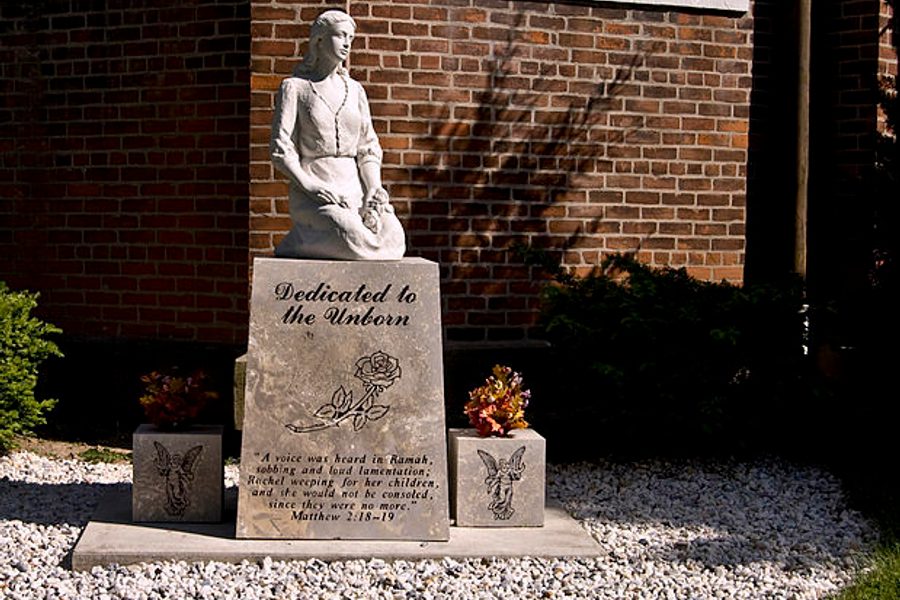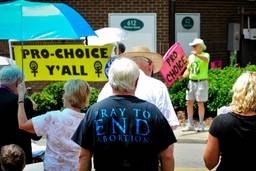Let’s Get Visceral
Anti-abortion activists plan memorial services for unborn fetuses, complete with tiny coffins.
Robin Marty

On the 40th anniversary of the Roe v. Wade decision this January, a somber group could be seen slowly marching outside the capitol in Jackson, Miss. Near the head of the procession was a tiny coffin, and inside rested the body of “Baby Daniel,” the lifeless remains of an abortion. Or so claimed the protesters bearing him along.
Daniel and similar “babies” are a regular feature of these memorial services—a grisly presence meant to engage anti-abortion advocates and remind them of every “life” they fight to save. The gruesome images are also designed to make the public feel repulsed by abortion. Despite the fact that over 90 percent of all abortions are performed in the first trimester and bear little resemblance to the thin-but-recognizable versions of full-term infants, many abortion opponents continue to use these bodies as rallying point of their activism.
In this vein, on Saturday, September 14, anti-abortion activists will visit fetal “burial” sites around the country to hold memorial services and prayer sessions. They have dubbed the date the National Day of Remembrance.
Abortion-rights advocates see such tactics as deliberately deception and manipulation. As one activist on a Facebook page called Protest Pro-Life Emotional Manipulation wrote regarding one giant placard, “This is purely emotional warfare. ‘Awww, look at the slightly chubby, graphically-modified-to-look-cuter fetus. It's so cuddly and non-life sustaining. How could anyone kill it?!’”
But in the minds of abortion opponents, the use of fully formed babies to represent fetuses may not be an intentional deception. “Living beings come into existence all at once and gradually unfold their world of innate potential,” writes TFP Student Action, a group of students and parents “dedicated to restoring traditional values on college campuses,” on its website. “A living human person begins to exist at the moment of conception, even though only as a cell. What is important is not the accident of size or weight but the essence—which is fully human. The unborn baby has a distinct, unchanging and unrepeatable genetic code, unique in all of history, from the moment of conception till death. Nothing is added except nutrition and oxygen.”
Like legislative maneuvers ranging from fetal homicide bills to the Life at Conception Act, the public display of fetal remains is another means for abortion opponents to make their argument that a baby is a baby, whether inside the womb or out, regardless of if it is a few cells old or a few weeks from birth. After all, if a person truly believes that life is unique and deserving of all protection at the moment that sperm meets egg, there is no moral or spiritual distinction between an abortion of an embryo before it has developed limb buds and the termination of a fetus past the point of viability. The “memorial”—or protest activities such as displaying large, graphic abortion images—thus becomes an attempt to translate abortion opposition into language that everyone can understand, a way of saying: “If you can’t see that abortion is the murder of a baby at six weeks, can you at least recognize it is a baby at 33 weeks?”
Memorial services for fetal remains have been occurring ever since the since the “rescue” movement of clinic blockades and harassment developed in the early 80’s. In her book Abandoned: The Untold Story of the Abortion Wars, writer and anti-abortion activist Monica Miller details the history of the Pro-Life Action League, founded in 1980, and its forays into dumpsters and shipping areas near Michigan Avenue clinics in Chicago to gather and photograph fetal remains. The bodies from these “retrievals” would be placed in coffins and given funerals, then buried by the hundreds. Although early internments were somewhat private affairs, they soon began to grow in both scope and public attention. There was some dissention among the activists over whether a mass burial was appropriately valuing individual lives, but the message concerning the reason for these burials was not debated.
“Just as Antigone was compelled to bury her brother despite the prohibition of the law, so we performed the familial duties for small bodies left on the loading dock,” wrote Miller. “God alone sees the hidden corpses cast out of our cities, lost in our sewer lines, buried in landfills and vanished in the smoke of waste incinerators, denied even the burial of dust.”
The September 14 action will commemorate the 25th anniversary of one of the largest such burials, when Miller and her colleagues buried “several hundred abortion victims” at a site Milwaukee in 1988. Activists say they intend to visit 35 different “burial” sites across the country. There, they will pray to end abortion and for the healing of those who have terminated pregnancies.
Healing after an abortion is a significant issue for Father Frank Pavone, national director of Priests for Life and co-director of the National Day of Remembrance. Pavone spoke with In These Times on September 10 about the reasoning behind the day of action.
Fr. Pavone spearheads a number of ministries under the Priests for Life umbrella—including Rachel’s Vineyard, a retreat for both women and men who feel they are suffering from grief or loss after an abortion—and he has also been intimately involved with fetal remains activism, speaking at numerous “services” for fetuses.
“[Memorials] become both an educational and a pastoral moment, when people are encountering the issue in a new way, and a lot of healing takes place, too,” says Fr. Pavone. ”We have found with Rachel’s Vineyard programs that it is an integral part of the healing itself to come face to face with the reality of the child. We want to help people connect the dots and say ‘This was your child and this was an important aspect of your life.’ As time goes on in the healing process, they need to face that. A ceremony like this will give a lot of these women—and the fathers, too—an opportunity to take that next step.”
But sometimes anti-abortion activists are ready for that “next step” to occur before anyone else is, including local authorities. Recently, Fr. Pavone spearheaded a mission to get the Philadelphia Medical examiners office to allow him to retrieve and bury the fetal remains from the Gosnell murder trial. Fr. Pavone held a ceremony to name the 45 bodies or fetal parts that were discovered on Gosnell’s property and entered into evidence.
“People have names. One of the first things we do when coming into the presence of another person – or even learning about their existence when apart from their presence – is to inquire as to their name,” Fr. Pavone said in a statement after the naming ceremony. “The name expresses the person, it invites the presence of the person, it both calls and welcomes the person, it acknowledges that there is something in common between the person and ourselves, and hence in receiving their name we offer our own. … But now it's time, in our collective journey through this nightmare, to connect with these children more directly. It's time to name the children.”
Naming them was not enough, and Fr. Pavone and his allies continued to demand the office give him the bodies for a proper funeral. Citing a policy that “Anyone, including friends and neighbors, may claim a body three days after the date of pronouncement of death,” the activists accused the office of playing abortion politics as a means of dehumanizing the fetuses. The office response was that the policy does not include unrelated third parties, and that if no related party stepped forward, they would be cremated in 10 years’ time.
This fight over the “Gosnell babies,” as Fr. Pavone and his associates have dubbed them, is fresh in their memory going into the National Day of Remembrance. Although the event was organized before the Philadelphia medical examiner’s refusal to release the remains from the Gosnell trial, the event still draws from momentum that anti-abortion activists gained during and after the murder trial’s media attention. For the most extreme of anti-abortion advocates, drawing attention to the “grave sites” and other memorials they have scattered across the country will provide another chance to put the literal faces of abortion back in the public square.
Abortion opponents say their intent is to simply honor the lives they believe have been lost and help those who have terminated pregnancies heal. But could these very public displays cause emotional duress, especially to those who have had an abortion, who may see the effort as pressure to make them regret their decision?
Fr. Pavone dismisses these concerns. “It will certainly for some become an uncomfortable moment. It may cause some people to react in a way that is, ‘Oh my gosh, I don’t want to hear about this or see this,’ and it may get people very upset. But in the same way, just the mention of abortion, a story on television or a headline … there are a lot of things about abortion that can trigger a person. Sometimes its just a visit to the doctor, or seeing a pregnant woman, or a baby carriage, or just the sound of a vacuum. There are so many different triggers.”
“Someone is not going to be harmed. Upset and harmed are two very different things,” added Fr. Pavone. “No matter how adamantly a person is opposed to abortion, they have to be just as adamant in their compassion and gentleness and love for people who have been through abortions, and understand where they are coming from, how they are feeling, and respect them and embrace them with compassion.”
While the naming, burial and memorial for the aborted fetus may symbolize love and compassion to the anti-abortion activists arranging the ceremonies, its further implications are undeniable. A memorial serves acts as one last attempt to force the public to accept the belief that terminating a pregnancy is the death of a child, whether or not the person having the abortion agrees with that assessment. Like the anti-abortion “sidewalk counselor” outside the clinic imploring a pregnant person to change her mind, fetal memorials are a final attempt to take that decision out of her hands.
If she won’t recognize or admit it was a baby, they will do it on her behalf.
Robin Marty is an activist, speaker and freelance reporter covering abortion access. She is the author of the forthcoming Handbook for a Post-Roe America (Seven Stories Press, January 2019) and Crow After Roe: How Women’s Health Is the New “Separate But Equal” and How to Change That. Robin’s articles have appeared at Bitch Magazine, Rolling Stone, Ms. Magazine, Truth Out, AlterNet, BlogHer, RH Reality Check and Care2.org, and she has spoken at trainings and conferences for NOW, NARAL, the National Conference for Media Reform and Netroots Nation.





